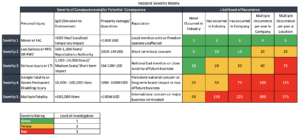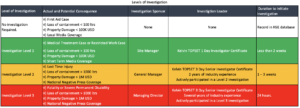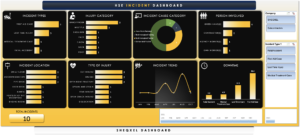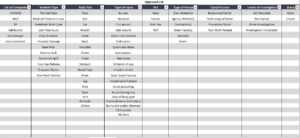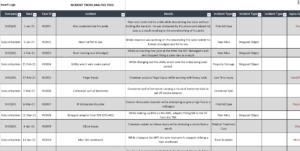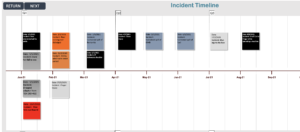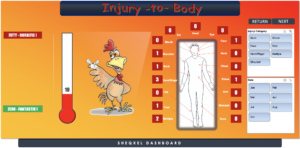
Incident reporting is an important element of the health and safety management system. According to the ISO 45001 clause (10.2) Improvement – Incident, Nonconformity and Corrective Actions: organizations must establish, implement and maintain a process for reporting, investigating and taking action to determine and manage incidents and nonconformities. When an incident occurs, organizations must react in a timely manner to the incident by taking appropriate actions to manage it.
Incident reporting involves the use of a number of tools. These are incident report forms, incident investigation report forms and systems for building a database of incidents to report trends. SafetyCulture.com has touched extensively on incident reporting, but missed the practical application of the guide.
This article seeks to provide the practical application of the guide on incident reporting, including evaluating preliminary information, carrying out an investigation and building a database of the incidents with a tool that can be utilized for incident trend analysis.
Table of Contents
What is incident reporting?
Incident reporting is the documented process of notifying top management or a designated person or an enforcement authority of an incident for the purpose of evaluation for further actions. The process involves an initial notification and a structured incident reporting process that takes into account the date and time, brief description of the incident, the type of activity, work equipment being used, the employees involved and the consequence of the incident. Incident reporting can be both internal and external; internally to persons within an organization and externally to an enforcement authority once an incident falls within a given category.
a) Initial notification – Incident reporting begins with an initial notification, which is done immediately to a designated person e.g., safety officer or an immediate supervisor. The purpose is to preserve all relevant data, knowledge and evidences about the incident by the designated person to prepare for the next stage of incident reporting i.e. preparing a preliminary incident report. The initial notification takes the form of an email, phone call or face to face communication.
b) Preliminary incident report is a report put together to provide preliminary information about the incident to top management for the purpose of evaluation and decision making on the need for further actions – given that, not all incidents deserve the same level of action. Once initial notification has taken place, the supervisor or the safety officer must send the preliminary incident report to the HSE Manager, the most senior management personnel e.g., MD and all relevant persons as per procedure within a specified time e.g., 24 hours. The purpose of a preliminary incident report is for severity evaluation by the top management to decide on the needed relevant actions.
What is incident severity evaluation?
Incident severity evaluation is the process of assessing the severity of the consequence or the potential consequence of an incident to determine the impact on business. Why is incident severity evaluation that important?
The fact is, not all incidents require the same level of investigation. As with all health and safety programs, investigation requires resources. The resources deployed for investigation include; competent investigation team, time off for the investigation, cost of mobilization and demobilization of the team, among others which can have a huge cost implication on an organization, depending on the complexity of the incident. The unplanned nature of incidents already puts a strain on existing resources, hence, incident severity evaluation should be carried out using an appropriate decision matrix to justify the need for relevant actions such as investigation and the level of investigation is required.
Factors to consider when evaluating incident severity.
The two most important factors to consider are the actual and potential consequences of the incident. The impact of an incident must be evaluated based on the preliminary information gathered and weighed against the severity of the consequences as outlined below:
a) The degree of personal injury – The degree of personal injury can range from minor to major injury. Minor injury is an injury that can be painful but does not threaten life, mobility or long-term survival. Examples are shallow cuts or abrasion, bruises, sprain and muscle strain. Treatment of a minor injury can be a simple first aid treatment. A major injury is an injury that is disabling and life threatening. Examples can be compound fracture, head or eye injury, deep lacerations, stab wounds etc. and can be categorized under various classes such as Medical Treatment Case, Restricted Work Case, Lost Time Injury and Fatality. The more sever an injury is the higher is the level of investigation required. A First Aid Case cannot attract the same level of investigation as a Fatality.
b) The cost of property damage – The cost of property damage also determines the level of investigation required. Property damage can range from minor repair works, major repair works to a total replacement of an asset or a piece of equipment or an assembly and the cost involved can range from a few hundreds of dollars to millions of dollars. The higher is the cost of property damage, the higher is the level of investigation required.
c) The magnitude of the environmental spill – The magnitude of a spill to environment also determines the level of investigation required. A spill can be classified into major or minor spill based on the quantity of spillage compared to specified threshold limits and the hazardous nature of the substance. A spill of 100,000 liters of a hazardous substance definitely needs a higher level of investigation than an 80 liter spill of a hazardous substance.
d) The extent of damage to corporate image – The extent of damage to corporate image also play a role in the determination of the level of investigation to be applied. A persistent national negative coverage posing a long-term impact on brand or loss of future would justify the highest level of investigation to repair any damaged reputation, compared to local negative media coverage which pose an insignificant impact on business operations.
e) The potential consequences of the incident –Finally, the potential consequences of all the above can inform the level of investigation. The rule of thumb of taking into account potential consequence is that, if the worst potential consequences are higher than the actual consequences, an investigation level must be set accordingly.
All these factors can be summarized in a decision matrix as part of an incident reporting and investigation procedure.
What is an incident severity matrix?
An incident severity matrix is a tool used to analyze and evaluate incident severity in order to determine the level of impact and the investigation required. This ensures that scarce resources are used judiciously to ensure balance between cost and benefit of risk mitigation. The decision matrix helps to justify the level of investigation required based on priority. This term can vary from one organization to the other but implies the same concept e.g., investigation level matrix or consequence matrix etc. Comment below how you call yours. Below is a typical decision matrix for determining the level of investigation
Levels of investigation
The depth of an investigation must be proportional to the severity of the consequence or potential consequence of the incident as per the incident severity matrix. Most organizations may have their own levels of investigation. The levels must determine the scale of resources, authority, responsibility and timeline that must be allocated to initiate an investigation. It also informs the need for notification to an enforcement authority.
What is the process of incident investigation?
The process of investigation continues from the incident reporting. Once the level of investigation has been determined, below are the next steps to take.
Step 1 – Forming an investigation team
As per the matrix, an investigation sponsor who is a senior management person must ensure that the required resources are allocated. This include forming an investigation team and appointing an investigation leader who has the relevant competence and experience to carry out an investigation according to the level of investigation required. The competency requirements includes Kelvin TOPSET Investigator Certificate or any equally important investigation course in addition to an experience in the operations and in carryout such level of investigation.
Step 2 – Determining the incident statement
The investigation team must agree on the formal incident statement that describes the key factors needed to carryout the investigation.
An incident statement is a statement of what happened, the actual consequence and the potential consequence. It is important that this is well established, since getting the incident statement wrong can largely affect the outcome of the investigation. Here is an example of an incident statement deduced from a worker who has been reported to have fallen off a ladder while working at height leading to an injured head.
- What happened? Man fell off a ladder
- What was the consequence? He injured his head.
- What was the potential consequence? He could have died.
This gives an opportunity to gather more information about the circumstances related to the incident. This plays a very key role in root cause analysis.
Step 3- Gathering the information
The most effective method of gathering information is to adopt a systematic approach like using a checklist which helps the investigation team to focus on all important elements of the work related to the incident. The checklist must address the following:
Task
- Was safe procedure used?
- Were the applicable tools and equipment used?
- Had conditions changed the task?
Equipment
- Was the equipment suitable for the job
- Was the equipment poorly designed?
- Was PPE used?
People
- Was the worker experienced?
- Was he adequately trained?
- Was he tired?
Environment
- What was the weather condition?
- Was it too hot or cold?
- Was there adequate lighting?
Material
- Was the material hazardous?
- Was the hazardous material properly contained?
Management
- Was there adequate supervision?
- Was there a written procedure?
- Was there adequate system of maintenance?
How facts are collected for analysis
- Photographs
- Measurement
- Document reviews
- Witness Statements
- 5W and H. That is the use the following
- What?
- When?
- Who?
- Where?
- Why?
- How?
- Interviews
Interviews are the most delicate aspect of incident investigation process as perception can easily be distorted due to consensus views from discussions among the witnesses which can affect the facts of the incident. To avoid this, witnesses must be interviewed alone and as soon as practicable. The do’s and don’ts of interviewing ;
Do’s
- Put the witness who is probably upset at ease
- Emphasize the real reason for the investigation i.e., to determine what happened and why
- Let the witness talk and listen
- Try to sense any underlying feeling of the witness
- Make short notes only during interview
Don’ts
- Intimidate the witness
- Interrupt while witness is talking
- Prompt the witness
- Asked leading question
- Show your emotions
- Make lengthy notes while witness is talking
- Asked closed questions which can be answered by a simple yes or no.
Step 4 – Analyzing the evidence gathered
After gathering evidence, the investigation team must analyze the evidence taking the following factors into account:
Physical factors
- Position of the equipment in relation to other equipment/facilities
- Condition of equipment, including maintenance history
- Position of controls, switches, valves, etc.
- Accessibility
- Inappropriate design
- Inadequate controls protecting against hazardous
- Illumination levels and types
- Housekeeping
- Evidence of disturbance, smells, discoloration, spills etc.
- Weather conditions.
Human factors
- Any psychological precursors related to the tasks performed
- Experience, training, competence, behavioral aspects
- Policies e.g., incompatible goals (personal, time, budget etc.)
- Organization structure/ line of command
- Communication
- Error enforcing conditions e.g., attitudes (low morale, mistrust of management, over confidence), tiredness, and stress.
Administrative factors
- Policies, procedures, risk assessment process
- Rules and regulations applicable to the incident
- Verification documents e.g., certificates, etc.
- Use of permits e.g., Work Permits, Deviation Permits, etc.
Step 5 – Conducting root cause analysis
Root cause analysis is the process of identifying all the contributory factors of an incident from the immediate cause to the most basic cause. The purpose of root cause is not only to identify the root cause but all the contributory factors in a sequential order.
- Immediate cause is the agent of causation to the injury or ill health e.g., the blade that directly caused the incident.
- Underlying cause is the unsafe acts and conditions that resulted to the immediate cause of the incident e.g., the guard removed, improper hand placement etc.
- Root cause is the failure from which all other failings grow or the most basic cause of the incident.e.g., poor system of maintenance.
Examples of methods of root cause analysis
- 5 Whys Technique is the process of asking why until the why cannot further be answered.
- Fault Tree Analysis is a deductive approach to establishing causes from defining the top event e.g., the explosion, and working backward logic to identify causes.
- Event Tree Analysis is an inductive approach that identifies and quantifies the possible outcome following an initial event such as an overfilled tank, and working forward to predict an explosion.
Step 6 – Writing an investigation report
An investigation report must be factual and clearly state where it is not e.g., in case of somebody’s opinion. The following must be included in an investigation report:
- Basic information surrounding the incident e.g., date, location and scene of incident
- Investigation team and leader
- Facts about the incident e.g., sequence of events, reactions of the personnel involved, observations by the investigation team etc.
- Causes of the incident. These shall include both the direct and root causes. If the precise causes cannot be established, then possible causes shall be described, and recommendations made as to how these possible causes can be confirmed or otherwise
- The performance of the applicable control elements and systems that were in place e.g., detection systems, fire-fighting equipment, alarms, emergency response organization, use of personal protection equipment, inspection of material etc.
- Consequences, both short- and long-term, of the incident e.g., level of injuries, damage to equipment, damage to the environment etc.
- Conclusion describing the root causes
- Recommended corrective (remedial) actions, including immediate, short- and long-term
- Appendices e.g., witness statements, logs of events, print outs from alarm control systems, schematics showing the scene and/or equipment involved,
Format of an investigation report
- Cover Page – Incident title and date
- Table of Contents
- Investigation Process
- Investigation Team Members and Roles
- Investigation Team Members arrival at scene
- Description of the investigation process including timing and methods used, e.g., investigation methodology, meetings, interviews, etc.
- List names and positions of people identified for interview. Indicate any reasons for not interviewing as applicable.
- Executive Summary : Brief description of the event, its consequences and the main conclusions of the investigation.
- Facts About the Incident : Facts in a chronological order and description of sequence of events, including the timelines of events.
- Observations : Description of findings and observations made by the investigation team.
- Consequences of Incident : Describe immediate and any long term consequence.
- Controls in Place Relevant to the Incident : Procedures, instructions, training and organizational issues. Technical barriers incl. detection and alarms
- Causes of the Incident : Relates to all the contributory factors as outlined below:
- Immediate cause
- Organization
- People
- Environment
- Technology
- Underlying causes
- Organization
- People
- Environment
- Technology
- Others
- Root causes
- Organization
- People
- Environment
- Technology
- Others
- Immediate cause
- Conclusion
- Investigation Team Leader’s conclusions including descriptions of reasoning and references to Event Trees, Interviews, Observations, Technical findings etc.
- List names and job title of people selected for interview. Indication of reasons for not interviewing as applicable.
- Recommendation
- Include details of what, who, when and any verification requirements e.g., audit.
- Distinguish between organizational items (e.g., training), technical items (e.g., modifications) and management system (e.g., procedures and policies)
- Immediate (remedial action that will temporarily maintain safety integrity)
- Short-term (preventive action that can be executed at short notice)
- Long-term (preventive action involving long lead items or processes)
- Appendices
- Statements, interview transcripts etc.
- Photos, videos, drawings, plans etc.
- Certificates, data sheets, technical documents
Why should you carry out incident investigation?
- To comply with the legal requirements
- To identify immediate, underlying and root cause to prevent their reoccurrence
- To identify all the barriers that failed in order to correct them
- To share lessons learnt with workers and across the industry to prevent from reoccurring
- To improve the moral of workers that management cares
- To improve the safety management system
- To ultimately improve safety performance
Why should you analyze your incident trends?
You can’t improve what you can’t measure – Darren Hardy
Every organization must analyze their incidents for the following reasons:
- To establish incident trends and make data driven interventions
- To run safety campaigns that addresses real workplace challenges
- To establish the common causal factors to incidents
- To establish which work activities is mostly involved incidents
- To establish which workplace equipment or work location is commonly involved in incident.
A simple tool for conducting incident trend analysis
There is a lot of EHS software on the web for performing incident trend analysis. Most are web-based applications but can be very expensive due to their subscription-based pricing charged yearly for users. The decision for such software largely requires huge financial resource and top management commitment. Also, safety professionals must be able to justify why an organization needs such a system. The good news is, small businesses and individuals can a ton of money using Microsoft excel template that does the exact same job and provides better control.
The HSE Incident Trend Analysis Tool is a simple analytical tool designed from Microsoft excel, effective to analyze your incidents. The template is designed for recording incident in the most relevant structure to establish trends and present on dashboards for decision making. The template has these features;
The Approved List is the setting section where users can predefine their incident types, the body parts where injury can affect, the types of injuries, sex, types of persons, levels of investigation and status of the investigation.
The Source Data is the main working area where data is entered. This takes into account the date of incident, title of incident, details, incident types (1,2 & 3) to account for incident with more than one classification; injury category, type of injury, downtime (hours lost), related activity, related equipment or material, location, underlying causes, cause category, type of person involved, sex, level of investigation and status of closure, which present a comprehensive structure for building a good database of incidents for good analysis.
The Incident Timeline presents a good storyboard for displaying the timeline of incidents for meaningful see at glance analysis. This can be printed out and displayed on noticeboards to communicate to all persons to focus on zero accident every month. The timeline gives a visual appeal to workers to align and participate in safety programs.
The Dashboards are two (2) and all are dynamic to visualize the data from the source sheet with just a Click. The Incident Dashboard features incident type, incident location, incident trend, injury category, injury type, incident cause category, type of person involved and downtime from incident. The Injury to Body Dashboard shows the various body parts affected by personal injurious accidents. This helps to channel focus on data driven campaigns such as Hands and Finger Injury (HFI) Campaign, Dropped Object Prevention Campaign etc. based on which part of the body injury is prevalent.
The Various Reports are tables and graphs of the relevant data from the source sheet for further drill down by users for easy predictions and implementation of proactive timely interventions.
This is tool is good for organizations, small business and individuals who cannot afford the expensive proprietary system on the market but want to work efficiently with a template that equally does the job.
Grab your copy and thank me later 🙂
Sel 💫 at SHEQXEL. Connect with Sel 💫 on LinkedIn
If you like it, sign up, comment or share.

